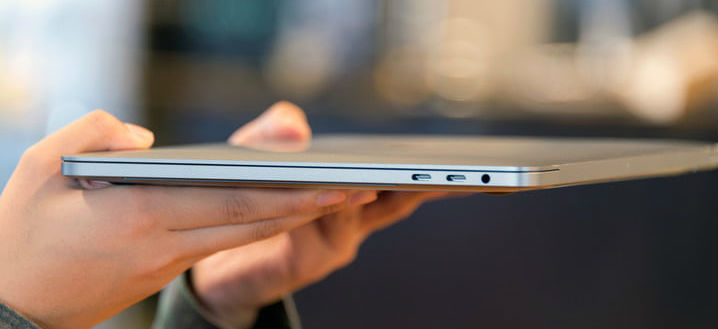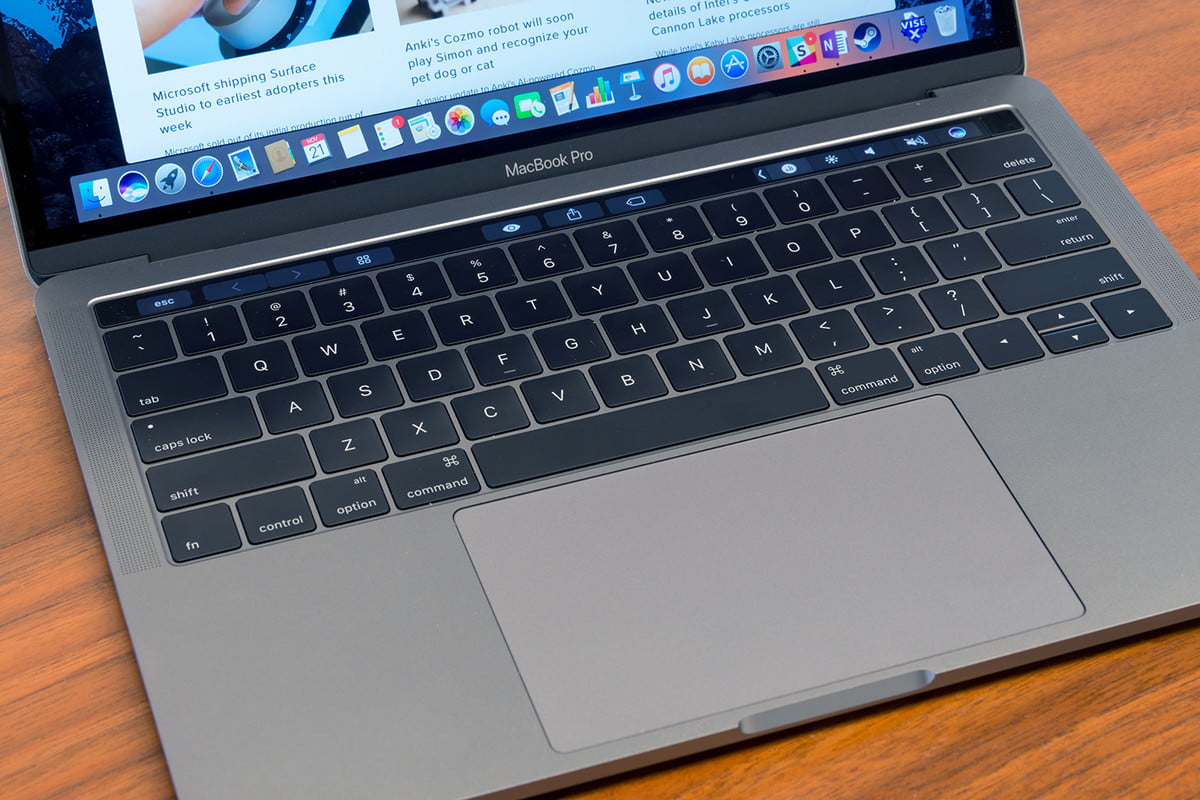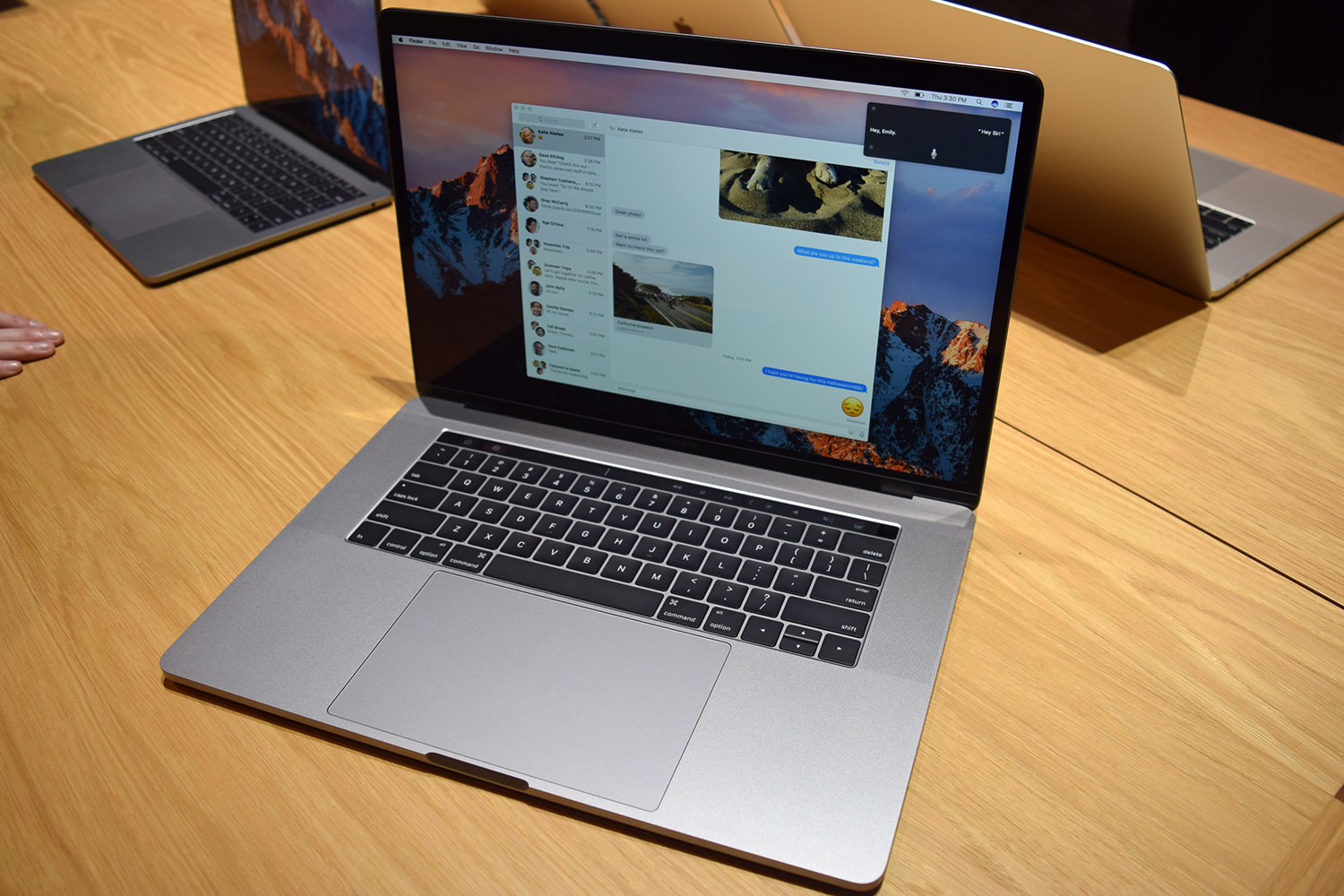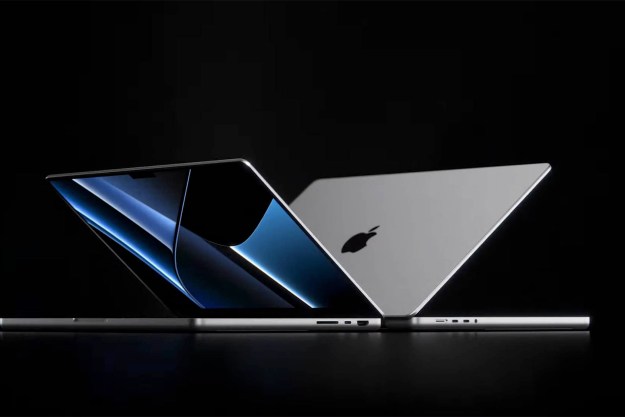The iPhone may be Apple’s most popular product, but the company hasn’t forgotten about its former flagship, the MacBook. In late 2016, Apple revealed the new face of the MacBook Pro lineup, including three new laptops with updated hardware (two of which feature the newly-unveiled Touch Bar feature). The Touch Bar is an OLED multitouch display, one designed to replace the function keys at the top of the keyboard and provide custom shortcuts for whichever app is at hand. It’s a headline-worthy feature, to be sure, but it might not be for everyone. Fans of the MacBook may wonder whether they should get one of these new machines and, if so, which one.
Read on as we break down the specifications and features for the MacBook Pro 13 vs. MacBook Pro 16.
|
MacBook Pro 16-inch (Touch Bar)  |
||
| Dimensions | 11.97 x 8.36 x 0.61 inches | 14.09 x 9.68 x 0.64 inches |
| Weight | 3.1 pounds | 4.3 pounds |
| Keyboard | Full-sized backlit keyboard with Touch Bar | Full-sized backlit keyboard with Touch Bar |
| Processor |
1.4GHz quad-core Intel Core i5 /
1.7GHz quad-core Intel Core i7 / 2.0GHz quad-core Intel Core i5 /
2.3GHz quad-core Intel Core i7 |
2.6GHz 6-core Intel Core i7 / 2.3GHz 8-core Intel Core i9 / 2.4GHz 8-core Intel Core i9 |
| RAM | Up to 32GB | Up to 64GB |
| Graphics |
Intel Iris Plus Graphics 645
|
AMD Radeon Pro 5300M with 4GB of GDDR6 memory / AMD Radeon Pro 5500M with 4GB of GDDR6 memory / AMD Radeon Pro 5500M with 8GB of GDDR6 memory / AMD Radeon Pro 5600M with 8GB of HBM2 memory |
| Display | 13.3-inch Retina display | 16-inch Retina display |
| Resolution | 2,560 x 1,600 | 3072 x 1920 |
| Storage | 256GB SSD / 512GB SSD / 1TB SSD/ 2TB SSD / 4TB SSD | 512GB SSD / 1TB SSD / 2TB SSD / 4TB SSD / 8TB SSD |
| Networking | 802.11ac Wi-Fi, Bluetooth 5 | 802.11ac Wi-Fi, Bluetooth 5 |
| Ports | 2 / 4 x Thunderbolt 3 (USB-C) ports | 4 x Thunderbolt 3 (USB-C) ports |
| Webcam | 720p FaceTime HD camera | 720p FaceTime HD camera |
| Operating System | MacOS Catalina | MacOS Catalina |
| Battery | Up to 10 hours web browsing | Up to 11 hours web browsing |
| Price | $1,299+ | $2,399+ |
| Availability | Apple | Apple |
| Review | 6/10 | Hands-on |
Design and features

The basic 13-inch MacBook Pro should look familiar to longtime users. The aluminum unibody is as striking as ever, and the new trackpad — which is significantly larger than the previous one — should give users a bit more freedom when performing multitouch gestures. The 13-inch and 16-inch MacBook Pros look almost identical, aside from the size of the display, touchpad, and speaker grills. As for color options, all three of the new MacBooks come in either silver or Space Gray.
In terms of features, there are some differences here. The new models have the Touch Bar built into the keyboard, replacing the function keys with a new touch interface. The Touch Bar retains all the functionality of the old keys, allowing users to adjust lighting, sound, and other facets on the fly. More importantly, it adapts to each program the user opens. However, its placement means it doesn’t end up being very useful.
While we don’t like the Touch Bar all that much, Touch ID is a fantastic inclusion in these laptops. Touch ID works great and gives you an extremely efficient way of unlocking your laptop with your fingerprint. It’s sorely missing on the MacBook Pro without Touch Bar.
The basic 13-inch MacBook features two Thunderbolt 3 (USB-C) ports that can be used for charging devices and connecting displays, while the upgraded 13-inch and 16-inch models each feature four of these Thunderbolt ports. There’s no HDMI port or SD card reader, but it’s nice to see Apple push forward with next-gen connectivity. If only Apple offered four
Winner: MacBook Pro 16-inch
Performance

MacBooks have never been the most powerful laptops around, but they’ve always been a dependable midrange option, and that continues to be the case with the new 13-inch MacBook Pro models. The cheaper version sports a 1.4GHz quad-core eighth-gen Intel Core i5 processor, while the more expensive model has a 2.0GHz quad-core 10th-generation Intel Core i5. The 2.0GHz model has a higher clock speed, and since both processors are quad-core, the higher clock speed should translate to quicker performance.
The new 16-inch MacBook Pro takes things to another level. The base model has a 2.6GHz six-core ninth-gen Intel i7, but for an additional $300, you can net a model with a 2.4GHz 8-core ninth-gen Intel i9 processor. Having two times the cores means the i7 (or i9) can handle multi-threading applications far better than a quad-core.
Both the low and midrange 13-inch models have 8GB of 2133MHz LPDDR3 RAM, while the more expensive 13-inch sports 16GB of 3733MHz LPDDR4X RAM. The 16-inch MacBook Pro comes stock with 16GB of 2666MHz DDR4, which is enough for many of the more demanding games and animation software on the market. Overall, the new
All 13-inch models use Intel Iris graphics of the HD 645 variety. They’re not bad, but they’re also not great for gaming or other GPU-heavy tasks. For that, you’ll want the 16-inch model, which has AMD Radeon graphics based on Polaris architecture.
Winner: MacBook Pro 16
Display
All three of these MacBooks use LED-backlit Retina displays with IPS technology, so the decision here really comes down to personal preference. The 13-inch models tout 2,560 x 1,600 pixel resolution at 227 pixels per inch, with support for millions of colors. The 16-inch model has 3072 x 1920 resolution, but the pixel density is slightly lower at 220 ppi, due to the larger screen size.
While a 15-inch screen offers more real estate for watching videos and editing images, it will also take up more space. Both of these choices offer similar quality in terms of brightness and color.
Winner: Tie
Portability

Apple touts these new MacBooks as the slimmest yet, and that goes a long way toward portability. The 13-inch models weigh in at a petite 3.1 pounds, and given they’re a mere 0.61 inches thick, they should be easy to carry in most bags.
The 16-inch model is a bit bulkier at 4.3 pounds, with a thickness of 0.64 inches. For users on the go, these are all remarkably portable machines, but if you have limited carrying space, you may wish to opt for one of the 13-inch models.
Winner: MacBook Pro 13
Availability and price
Anyone hoping the new MacBooks would cost the same as the previous generation may want to crack open the piggy bank — and probably check out some cheaper alternatives, too. The basic 13-inch model starts at $1,300 with the reduced 256GB of solid-state drive storage, while the mid-range 13-inch version will cost a whopping $1,499 — and that’s just the baseline configuration. Additional memory and a faster processor cost extra. If those numbers make you queasy, consider moving toward a couch before you read on.
The 16-inch MacBook Pro starts at $2,399. Users who want a bit more power can upgrade to the version with a 2.4GHz eight-core ninth-generation Intel i9 processor for $2,699.
Winner: MacBook Pro 13-inch
Conclusion

The new 16-inch MacBook Pro is easily the most impressive of the bunch, sporting the promising (if puzzling) Touch Bar and some solid hardware under the hood. Still, those features come at a daunting price.
All things considered, the average user who’s weighing either buying the entry or midrange 13-inch MacBook Pro may want to stick with the entry-level 13-inch MacBook Pro — despite the bump in storage space you get, the baseline midrange model is just not worth the extra $200 it costs.
Editors' Recommendations
- Best refurbished MacBook deals: Get a MacBook Air for $140 and more
- Best laptop deals: Save on the Dell XPS 14, MacBook Pro 16 and more
- MacBook Pro OLED: Here’s everything we know so far
- The XPS 16 is fighting an uphill battle against the MacBook Pro
- The 5 best MacBooks for video editing in 2024




